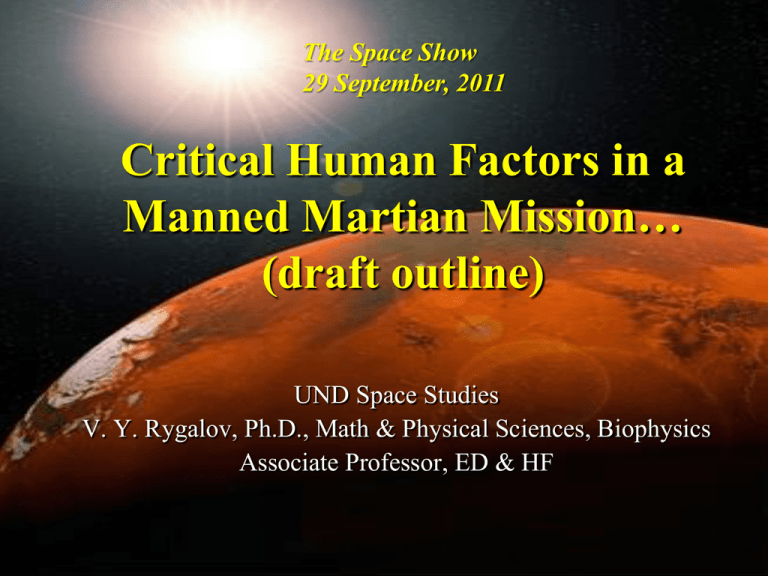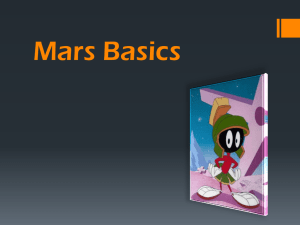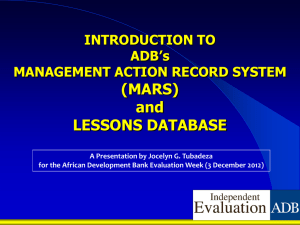CriticalHumanFactorsLongDurationSpaceFkight
advertisement

The Space Show 29 September, 2011 Critical Human Factors in a Manned Martian Mission… (draft outline) UND Space Studies V. Y. Rygalov, Ph.D., Math & Physical Sciences, Biophysics Associate Professor, ED & HF Agenda Outline Earth vs. Space Environments Life Support in Space PLSS Physiological & Medical Aspects Individual & Group Psychology… Mission Profiles Mission Strategy The Split-Mission Approach ISRU & Hybrid LS Motivation for Martian Mission… Earth ‘Biosphere’ Gravity fields (g 9.81 m/s2) Magnetosphere Atmosphere (N2~78%; O2~21%; CO2; O+3, etc.) Pressure (101.1kPa=1atm, at sea level) Illumination (1387W/m2; day/night cycle) Surface temperatures: ~ -80OC to +60OC… local variations… Seasonal climate changes… geographical variations… Day/night temperature variations are rarely 10 15OC Global material circulation and gradients: water, O2/CO2, tectonic/sedimentation (minerals) Earth ‘Biosphere’ Global material circulation and gradients: water, O2/CO2, tectonic/sedimentation (minerals) Human populations are distributed in the zones with high material & energy gradients (not circulation!) To minimize energy for food collection & environmental control Populations are tied up to the sources of energy for environmental control Ecological processes (food pyramids…) We are not at the top of food pyramids naturally By variations of local environments we can get to the top… Social environments… Social environments are sequence of continuous efforts to survive in ‘hostile environment’ of Earth Human Physiology… ‘Respiratory Machines…’ (O2/CO2…) Bio – Chemical reactors CVS +… + Homeostasis (adaptation to environment) Operational Elements Skeleton Muscles Control Systems CNS (environment monitoring & orientation) Perception & Cognition Technological Interfaces (survival & comfort) Industry/Machines & Tools… balance environment… Environments on the way to Mars… Earth surface (No problem… practically…) Risk to human life… Minimal… Extraterrestrial bodies (Mars) Risk… Low & depends on hardware (technologies)… In-Space Environments Open Space: Risk… Intermediate Space Capsule: Risk… Intermediate - Low… Active Space Environments (Transitional…) Surface of Earth to near Earth… Surface of Mars to near Mars Risk… High… Technologies work at the limits… Open (interplanetary…) space environment 0 – g & G - Forces Radiation (ionizing, UV, solar flares…) Thermal variations Debris (asteroids, meteoroids, man-made) Vacuum No air… Lack of water… No ecology (food?...) Physiology alterations (SAS… 0 - g) Medical issues Material degradations (O-, radiation…) Durations… Technological Instabilities… Planetary Environment (Mars): • 3.73 m*s-2 = 38% of Earth gravity • E/magnetic radiation (light) ~ 615718W/m2 • Pressure ~ 0.7kPa (wind 60-80 m/s) • Dust- and thunder-storms • Temperature ~ 130K to 300K • UV radiation ~ 10 W/m2 • Estimated Dose Equivalent during Martian mission: Earth Mars ~ 0.32 Sv 30 days on Mars ~ 0.023 Sv Mars Earth ~ 0.35 Sv Van Allen Belts < 0.04 Sv Total: 0.742 Sv compare to 0.0034 Sv on Earth (same time) • Magnetic field can not protect outer Martian atmosphere from GCR and SCR (SPE) PLSS Life Support in Space… O2 supply and CO2 removal Water Food Environmental parameters control Wastes processing (re-cycling) Countermeasures to prevent SAS… Psychology of long-term confinement ‘Habitability’ Concept Hygienic & Medical issues… Duration Human Primary Life Support Requirements: Inputs Daily Req. Oxygen Food Water Outputs (% total mass) 0.83 kg 0.62 kg 3.56 kg 2.7% 2.0% 11.4% (drink and food prep.) Water 26.0 kg (hygiene, flush laundry, dishes) 83.9% Daily Carbon 1.00 kg dioxide Metabolic 0.11 kg solids Water 29.95 kg (metabolic / urine (hygiene / flush (laundry / dish (latent TOTAL 31.0 kg (% total mass) 3.2% 0.35% 96.5% 12.3%) 24.7%) 55.7%) 3.6%) TOTAL 31.0 kg Source: NASA SPP 30262 Space Station ECLSS Architectural Control Document Food assumed to be dry except for chemically-bound water. Life Support Approaches LS Function Comments Supply Physical/ Chemical Bio/ Regenerative + + + + Critical variable Water + + Food + - ??? + Critical variable Psychology -, ? -, ? + Required for long/term mission Autonomy -,+ ? -,+ ? + Required for long/term mission Reliability Technical/ Engineering Technical/ Engineering Technical/ Engineering + Bio(eco)logical Required for all missions (Methods of estimates?) Comments LSS is not heavy; short distances LSS is heavier; mission duration is longer LSS is heavy; long/term space missions Air Critical variable CELSS: Plants for Human Life Support… HUMANS Metabolic Energy food (CH2O) + O2 CO2 + H2O Clean Water Waste Water Light food (CH2O) + O2 CO2 + H2O Clean Water Waste Water PLANTS Some Findings from NASA Testing Closed System Studies: How Dr Rygalov thought it should work?... What the LPG design became…finally Send to Mars??? More ideas for Greenhouses More Greenhouses Copyright Sadler Machine Company 99 Lessons learned (ground tests) ESM analysis shows Bio-regenerative LS becomes competitive for P/C only with mission durations longer than 1.98 – 2.73 years = 723 – 997 days (reduced gravity is included) Bio-regenerative LSS are inherently unstable ‘Error’ accumulations happen in ~ 180 days Spare parts & buffer materials storage LSS environment changes Materials leaching, deposits and dead-locks Algorithm of Stability Control ?... Technology? Mission autonomy has to be up to the mission duration… Role of Bioregenerative Components for Future Missions Short Durations Longer Durations (early missions) Autonomous Colonies Stowage and Physico-Chemical Bioregenerative Plant Growing Area ~1-5 m 2 total ~10-25 m 2 / person ~50 m 2 / person Constraints for Crop Production on Mars: (“Economics” of Life Support) Energy Requirements System Mass System Volume Crew Time System Reliability… ISRU technologies ?... These Apply for All Life Support Technologies For Plants, Lighting Dominates These Costs ! CES have never been tested in space Physiological dynamics in space SMS (few days syndrome) Body liquids re-distribution Cardio – Vascular de-conditioning Muscles & Bones structural integrity losses Blood components RBC ~ Space Anemia… WBC ~ dynamics are not clear Immune System (IS) alterations Multiple Changes in 0 – gravity Physiological & Medical Implications Body liquid shift upward… Muscles weakening Bone de-mineralization and structural losses Ca+2 & Minerals balance disturbances Others Des-orientation in space & time Cardio-vascular de-conditioning (OI) http://www.youtube.com/watch?v=G2uSsgOBHDI&feature=related Radiation Doses Multiple Physiological De-Conditioning in 0-Gravity Human Physiology Changes in Micro-Gravity 15 10 % Changes from 1-g environment 5 Earth 0 Card Ind 0 2 4 6 8 10 12 Fluids Muscle -5 Bone Mass RBC Immune -10 NeuroVestib -15 -20 -25 Tim e, m onth Course of Re-adaptation to 1-g… Physiologic Readaptation to 1-g Environment 20 10 0 0 1 2 3 4 5 6 7 8 9 10 1-G % Changes -10 Clinical Irreversible Fluids -20 CardioVasc NeuroVest RBC -30 B-Mass -40 -50 -60 Tim e, w eek Psychology of Confinement: Motivation … 2 quarter… 4 quarter… Artificial Control 0 quarter, pre-mission 3 quarter… 1 quarter… Fifth phase! ~ 2 weeks before return… Effects of Isolation & Confinement Long-Term Confined & Isolated Groups: space stations, polar bases, remote terrains, high mountain expeditions, submarines, “new artificial worlds” (Biosphere-2, BIOS-3, “Mars500 ~ 500-700 days test”…) Symptoms: boredom, restlessness, anxiety, depression, headache, physical complaints, temporal & spatial disorientation, irritability, anger, occasional hostility, sleep disturbance… Deficits in individual (feelings of incompleteness & isolation) and group compatibility/performance Symptoms increase over time in isolation… Transcendent experiences (consciousness alterations)… Effectiveness/Efficacy losses, mission failure, serious survival problems… without external support Sensory deprivation… Mission profile options Short – Stay Mission Long – Stay Mission (minimum energy) Long - Stay Mission (fast transit) The Split – Mission Strategy Short – Stay Mission… Short stay on Mars but… Higher radiation exposure Transits through highest risk environments Trajectory is acceptable for cargo-ships Long – Stay Mission (min energy) Less risks associated with inner Solar System orbits but… Long exposure to the factors of open space environment (0 – g) Cargo-ships Long - Stay Mission (fast transit) Minimizes crew exposure to open space Maximizes surface stay Reasonable energy requirements Crewed Mission Earth Crewed Mars Mission Options Mars Moon Split Mission Strategy… Heavy Lift Capability… + Deployable Structures for Martian Habitat, Including Greenhouse… Conclusions Manned Mission to Mars is possible… … as a very RISKY enterprise… Key PLS technologies have been tested only in 1-g … and never been tested in altered gravities Bone losses and radiation effects remains unresolved issues ISRU concept have been tested… but in limited version and mostly on Earth 1-g environment Control algorithms ?... Technological maturity ~ 8-10 years of intensive efforts Psychology of high risk confinements ? Crew training ??? More than NEVY SEAL… Crew training… Professional training Technological & Physiological Science – Research Socio-Psychological Special physical/physiological training Special psychological resistance training… ‘Special endurance’ http://www.youtube.com/watch?v=3DeSyl1CGIQ Realism vs. Control Motivation ??? Why Go to Mars? (Courtesy of Prof. M. Gaffey) Biological Biological systems expand into new environments Social & Cultural Societies without external boundaries tend to become more internalized and restrictive Increase the number of “baskets” Technical Attempting the difficult is how progress is made Scientific Life on Mars? Comparative planetology Why Mars? (August’92, Houston, TX) Human Evolution (Bio-Technical) Comparative planetology (Science) International Cooperation Technological Advancements Inspiration Investments (in the future ?...) ??? There are NO any commercial or business related rationales behind mission to Mars… except ‘Extreme (Ultimate) Adventure…’ Why Go to Mars? (A. Maslow) Why should humans go to Mars?... Searching for ‘New Heavens’… (?) Exploratory Instincts… ? Testing for maturity of our technologies, integration, and risk taking capabilities… Searching for Life…? Self-Actualization (top of motivations) … And testing for our intellectual-mental limits… ‘Bio-Technological’ Evolution http://www.youtube.com/watch?v=lJMCrPb-EEM Questions & Discussion ? A Crewed Mission to Mars: http://nssdc.gsfc.nasa.gov/planetary/mars/marsprof.html









